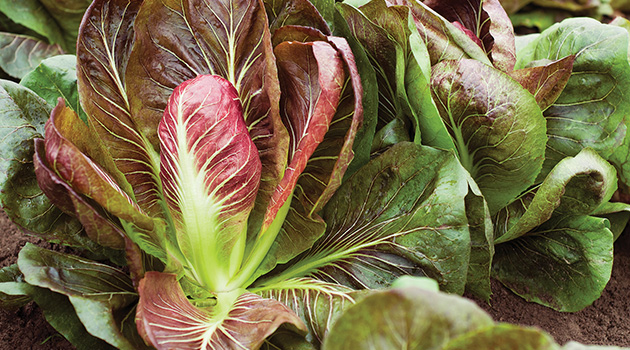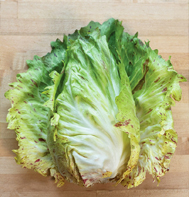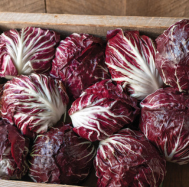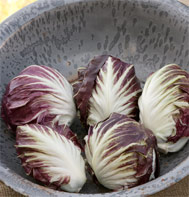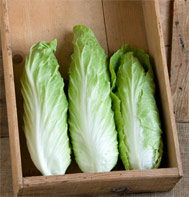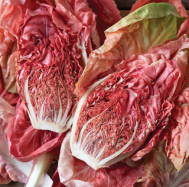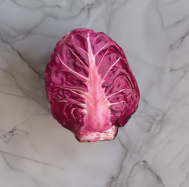- Chicory: Belgian Endive | Key Growing Information
- Radicchio Varieties | Succession Planting Program
- Radicchio | Key Growing Information
- Belgian Endive (Witloof) | Instructions for Growing & Forcing | Tech Sheet (PDF)
- Video: Baby Leaf Greens: 12 Picks for Market Growers | Johnny's Webinar Series
- Radicchio & Sugarloaf Chicories | Growing Instructions | Tech Sheet (PDF)
- Video: Using Blanching Caps to Blanch Frisée (Chicory) in the Field at Satur Farms
- Winter Growing | Recommended Crops & Varieties
- Baby Leaf Greens: 12 Picks for Market Growers | Johnny's Educational Webinar Resources
- Video: Johnny's Season Extension & Overwintering Trials
- Italian Dandelion Chicory | Key Growing Information
- Johnny's Planting & Harvesting Programs
- Chicory: Endive & Escarole (Cichorium ssp) | Key Growing Information
- Baby-Leaf Chicory | Key Growing Information
- Radicchio Varieties | Comparison Chart / Planting Program (PDF)
Johnny's RADICCHIO Planting Program
Radicchio Succession Planting & Season Extension
There are several types of radicchio, also known as Italian chicory (Cichorium intybus, Asteraceae). When different varieties are planted, their varying cultural characteristics enable growers to produce this crop across the seasons.
Johnny's Radicchio Planting Program is specifically designed to take the guesswork out of succession-planting the different varieties, allowing you to maximize your harvest window. To achieve a successful extended harvest, choose varieties by their transplanting and harvesting slots, as depicted in our chart below, as well as by their days to maturity.
Additional distinguishing features to consider as you formulate your planting program include each variety's open-pollinated or hybrid status; availability of organic or conventional seed; and the type of radicchio, names for which reflect selection and preservation of various head forms and coloration characteristics by families and farmers in different regions of Northern Italy — round rosso di Chioggia, speckled variegata di Lusia and variegata di Castelfranco, and tall rosso di Treviso and sugarloaf types, among others.
- Broccoli • Standard Heading Varieties • Planting Program
- Broccoli • Mini & Sprouting Varieties • Planting Program
- Brussels Sprouts • Planting/Harvesting Program
- Cauliflower • Planting Program
- Leeks • Planting/Harvesting Program
- Lettuce • Full-size Head Varieties • Planting Program
- Radicchio • Planting Program
- Radicchio • Planting Program Comparison Chart • PDF Version
- Radish • Specialty & Daikon Varieties • Planting Program
- Spinach • Planting Program
- View ALL Planting Programs
Spring
Summer
Fall
Winter
| Type | Days to Maturity | Note |
| Variegato di Castelfranco | 50 | Early, pear-shaped heads, dense and compact, with variable red-to-pink-speckled leaves. Classic bitterness balanced with sweetness. Open-pollinated. Conventional seed. |
Spring
Summer
Fall
Winter
| Type | Days to Maturity | Note |
| Variegato di Lusia | 52 | Deep red- and pink-spotted heads for year-round harvest. Open-pollinated. Conventional seed. |
Spring
Summer
Fall
Winter
| Type | Days to Maturity | Notes |
| Round Chioggia | 55 | Extra-early; smaller heads for denser plantings. Open-pollinated. Conventional seed. |
Spring
Summer
Fall
Winter
| Type | Days to Maturity | Notes |
| Round Chioggia | 60 | Reliably produces high yields of marketable full-size heads with bold, red-purple color. |
Spring
Summer
Fall
Winter
| Type | Days to Maturity | Note |
| Round Chioggia | 65 | Excellent uniformity and high yield potential for summer harvest. Hybrid. Conventional seed or conventional seed with NOP-compliant pelleting. |
Spring
Summer
Fall
Winter
| Type | Days to Maturity | Notes |
| Round Chioggia | 65 | Uniform, dense, bright-purple heads for fall and winter harvest. Hybrid. Organic or conventional seed. |
Spring
Summer
Fall
Winter
| Type | Days to Maturity | Notes |
| Tall Treviso | 66 | Suitable for all cropping seasons. Hybrid. Organic or conventional seed. |
Spring
Summer
Fall
Winter
| Type | Days to Maturity | Note |
| Sugarloaf | 68 | Can be grown right through the season but performs best in spring and fall. Hybrid. Organic seed. |
Spring
Summer
Fall
Winter
| Type | Days to Maturity | Note |
| Verona | 115 | Expose plants to short days/cold weather to achieve pink color expression. |
Spring
Summer
Fall
Winter
| Type | Days to Maturity | Note |
| Costarossa | 120 | In the North, slot for late fall harvest. In the South, grow during winter or overwinter. |


